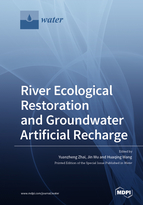River Ecological Restoration and Groundwater Artificial Recharge
A special issue of Water (ISSN 2073-4441). This special issue belongs to the section "Hydrology".
Deadline for manuscript submissions: closed (31 March 2022) | Viewed by 31374
Special Issue Editors
Interests: hydrogeology; hydrogeochemistry; environmental hydrogeology; riverbank filtration; geogenic pollution; anthropogenic pollution; groundwater pollution; groundwater remediation
Special Issues, Collections and Topics in MDPI journals
Interests: groundwater monitoring; groundwater quality assessment; risk assessment
Special Issues, Collections and Topics in MDPI journals
Special Issue Information
Dear Colleagues,
There is a strong relationship between river and groundwater in nature. With the large-scale exploitation of riverside groundwater resources, this has caused adverse ecological impacts on the river and groundwater environment, such as water table depression, land subsidence, dried up rivers and even dry-up, and vegetation degradation. Using ecological replenishment of the river to increase groundwater recharge is an important method of managed aquifer recharge (MAR), which can effectively solve the problem of groundwater overextraction, increase river flow, and improve water quality. There are still many scientific and technical problems due to the diversity of replenishment water sources and the complexity of the infiltration process and hydrogeochemical reactions, although many such water replenishment practices have been carried out worldwide—for example, the clogging of the infiltration process, the groundwater quality change caused by unpredictable hydrogeochemical reactions, the underground fate of emerging pollutants introduced by replenishment water, the coupled model construction of river–groundwater under water replenishment condition, and so on. In addition, an evaluation of the effect of river ecological replenishment on groundwater resources recharge, risk assessment of land subsidence and urban safety, and impact assessment of the groundwater environment are also urgently needed.
Prof. Dr. Yuanzheng Zhai
Prof. Dr. Jin Wu
Prof. Dr. Huaqing Wang
Guest Editors
Manuscript Submission Information
Manuscripts should be submitted online at www.mdpi.com by registering and logging in to this website. Once you are registered, click here to go to the submission form. Manuscripts can be submitted until the deadline. All submissions that pass pre-check are peer-reviewed. Accepted papers will be published continuously in the journal (as soon as accepted) and will be listed together on the special issue website. Research articles, review articles as well as short communications are invited. For planned papers, a title and short abstract (about 100 words) can be sent to the Editorial Office for announcement on this website.
Submitted manuscripts should not have been published previously, nor be under consideration for publication elsewhere (except conference proceedings papers). All manuscripts are thoroughly refereed through a single-blind peer-review process. A guide for authors and other relevant information for submission of manuscripts is available on the Instructions for Authors page. Water is an international peer-reviewed open access semimonthly journal published by MDPI.
Please visit the Instructions for Authors page before submitting a manuscript. The Article Processing Charge (APC) for publication in this open access journal is 2600 CHF (Swiss Francs). Submitted papers should be well formatted and use good English. Authors may use MDPI's English editing service prior to publication or during author revisions.
Keywords
- managed aquifer recharge (MAR)
- hydrogeochemistry in MAR
- risk assessment
- hydraulic clogging
- land subsidence
- coupled model
- emerging contaminants








